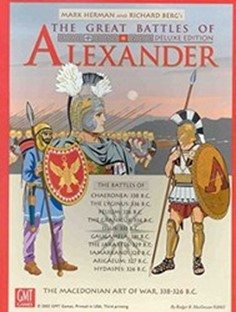 This battle was the first major battle in which Alexander took a significant role, as the commander of the left wing of his father’s army. At this stage, Athens and Thebes had formed a coalition against the Macedonian threat, but they had a problem: Philip was a much better commander, and his new way of organising his troops was eclipsing the old hoplite battles of the Greeks. This would be the end of Ancient Greece as a power on the world stage. After this, came the short-lived Macedonian Empire of Alexander, the wars of the Successors, and eventually the rise of Rome.
This battle was the first major battle in which Alexander took a significant role, as the commander of the left wing of his father’s army. At this stage, Athens and Thebes had formed a coalition against the Macedonian threat, but they had a problem: Philip was a much better commander, and his new way of organising his troops was eclipsing the old hoplite battles of the Greeks. This would be the end of Ancient Greece as a power on the world stage. After this, came the short-lived Macedonian Empire of Alexander, the wars of the Successors, and eventually the rise of Rome.
The Greek orator Demosthenes had whipped up the Athenians against the ambitions of Philip. In 338 BC, Philip attempted to forge a peace treaty with Athens, but his entreaties fell on deaf ears. So finally his army made contact with the Greeks on the fields outside Chaeronea. Demosthenes was with the army as a hoplite; this scenario has him as one of the commanders. It must be said that there is very little known about the specifics of this battle and the order of battles, so Messrs Berg and Herman have made a few educated guesses about the composition of the armies and how they were set up. And then I’ve come in with my fumbling strategies, to provide a narrative that doesn’t really follow the historical record all that well…
Here’s how the set-up looks, in any case:
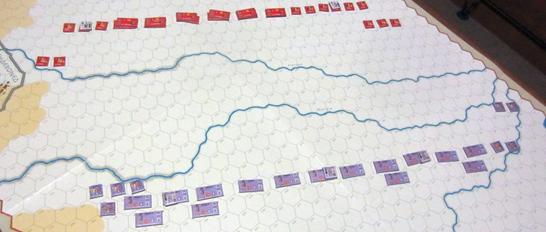
The Macedonians are in red to the top of the picture, the Greek alliance is in purple to the bottom. The Macedonian Phalanxes are double-depth (stacked), while the Greeks merely have hoplites. At the far right of the Greek line is the Sacred Band of Thebans, a small force but incredibly important as a symbol of Thebes – they’d done exceptionally well against the Persians, about 50 years before.
Alexander is with the Macedonian cavalry on the right.
One of the problems with the battlefield are the streams crossing it, which cause some loss of cohesion to armies moving through them. This is even more pronounced on the left side of the battlefield, where the banks of the streams are quite deep, which means the loss of cohesion is even greater – armies really need to pause after crossing to be rallied and reorganised, lest the crossing advantage their opponents too much. It very much is a situation in which I’d prefer not to battle at all – just sit back and see if the opposition is foolish enough to come to me. Unfortunately, that would make a very boring battle so I had the Greeks move forward, trying as much as possible to keep their lines intact.
This was pretty difficult, especially with the lack of command ability on the Greek side: they couldn’t activate all their units! As a result, their lines were pretty ragged by the time the first turn ended.
Meanwhile, Alexander took his troops off to cause problems on the flank of the Greek forces, while Philip just moved up to the stream with his phalanxes. Philip had the advantage of being able to use momentum activations to rally his forces, something the poor Greek commanders were not able to do reliably.

The second turn saw the first action of the game, with the peltasts of the Greeks running into Philip’s peltasts and heavy infantry. It didn’t go well for the Greeks, with most of their forward force across the river quickly moving to retreat.
Alexander brought his men up to the stream, ready to charge across and deal with the unprotected flank of the hoplites, while Philip brought his phalanxes across the first of the streams: still cautiously, as it was hard knowing what to expect from the Greeks.
Alexander failed his momentum die roll, by the way, so he wasn’t able to move all of his troops into position.

The third turn brought more manoeuvring, with Philip removing the cohesion hits from his phalanxes whilst his forward troops began to cross the river. The Greek commanders rallied some of their fleeing troops, but the others just fled off the battlefield. Alexander tried to trump a momentum activation of the Thebans (on the right), but managed to fail that to leave his forces out of position. He was fortunate the Greek forces weren’t being more aggressive, although it wasn’t good to be out of position when the Greeks would be activating first next round…
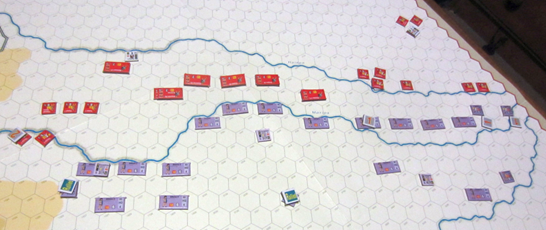
And then the opening manoeuvres were over, and the battle began in earnest. Alexander being out of position was a big deal, as it meant his troops weren’t able to properly engage the Greeks. Instead, it was Philip’s phalanxes that were now finding themselves being attacked on their flank! Alexander’s attempts to preemptively strike at the Greek flanks had opened up the hole, and the Greeks took advantage.
Meanwhile, the left flank of the Greeks was discovering that Philip’s men were pretty scary – they quickly lost their first hoplite troop on that side, 1000 men either dying or just getting out of there as quickly as they could (while trampling on the hoplites behind them!) Leaving a retreat path was rather important, especially given how the phalanxes were set up.
There was a chance for the Macedonians to strike against the exposed hoplites on the centre, but Philip failed his Momentum Die Roll with a “9”, and the dreaded Die Roll of Doom came up… another “9”! Philip, in a moment of madness, pulled his troops back, allowing the Greeks a moment of respite.
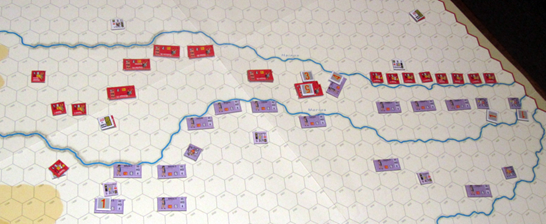
Once battle begins in GBoH, the nice lines disintegrate pretty quickly. When you have phalanxes and hoplite counters pivoting to attack each other from the flanks, they generally leave themselves vulnerable to someone else attacking them from the flanks! This got chaotic pretty quickly after that – the middle of the battle was a real mess. The Macedonians lost a double-stacked phalanx, though, which is a lot of men (and victory points for the Greeks).
It wasn’t all going well for the Greeks, though. Philips’ retreat gave the Athenian forces on the left a breather, but the middle was being pounded while giving a pounding in return. All very messy. And Alexander’s tactical nous finally came to the fore as he retreated his troops before an advance by the Thebans… before failing ANOTHER Trump roll and giving up the potential attack…
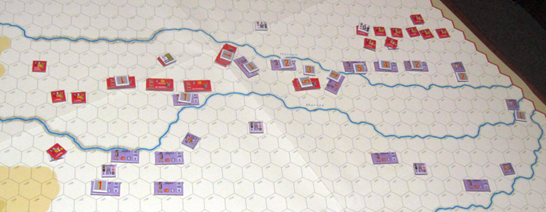
It was all set up for the Greeks to take action, but they weren’t going to get the opportunity. They routed another of the Macedonian double phalanxes, and it was immediately eliminated due to a lack of space to retreat, but then Alexander finally got his men into the right positions and demolished the Greek hoplites. It was a bloody affair.
Meanwhile, the Sacred Band stayed back, their commander having not given them the proper orders to advance!
Lots of routing Greeks crossed back over the river, and with no activations left – and certainly no rout points remaining – the Greeks left the field in disarray.
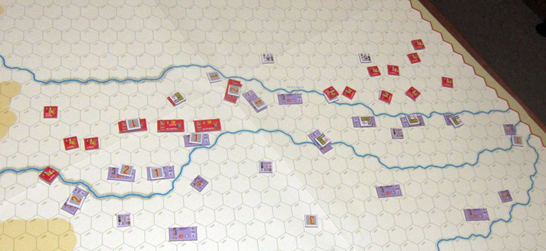
The Macedonians came out of the battle with 49 rout points remaining (having lost 56 points from four phalanxes). The Greeks? They’d lost lots! I wasn’t about to count them up, but there were three routing hoplite counters on the table, each which would be eliminated during the rout phase. I think that puts them about 20-30 points over their limit.
The scenario didn’t take that long to play solo – a couple of hours. (Actually three from start to finish, but I was doing other things during that time). The failed trump attempts of the young Alexander prolonged the battle quite a bit, but I’m sure the Thebans also needed to get more of their troops up to the front. Having lots of exposed flanks from troops moving too far forward was a bit of a problem!
